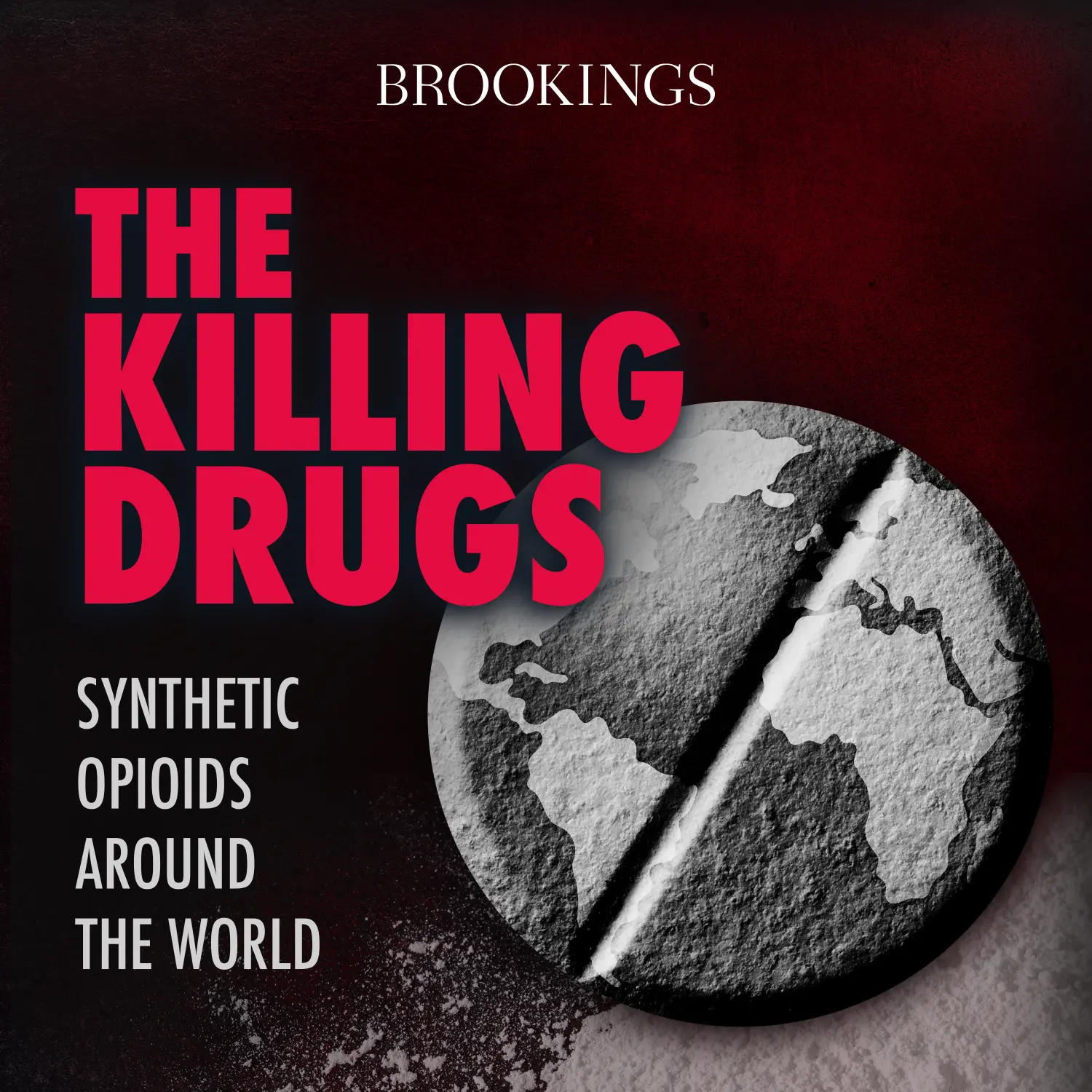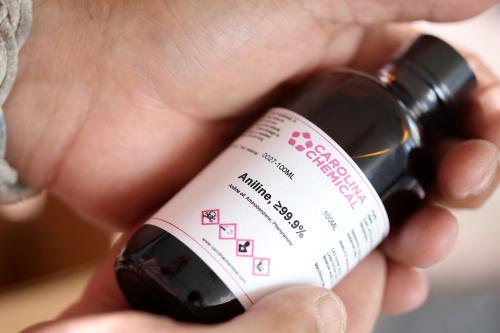In the show’s second episode, host Vanda Felbab-Brown talks with Dr. Peter Reuter and Dr. Greg Midgette, criminology professors at the University of Maryland, about the current state of the U.S. drug market, discussing changes to U.S. consumption patterns from cocaine to various opioids. The episode also explores the dramatic rise in lethality in the U.S. drug market, not just because of the widespread prevalence of fentanyl, but also because of the increasing potency of methamphetamine.
- Listen to The Killing Drugs on Apple, Spotify, or wherever you like to get podcasts.
- Watch episodes on YouTube.
- Learn about other Brookings podcasts from the Brookings Podcast Network.
- Sign up for the podcasts newsletter for occasional updates on featured episodes and new shows.
- Send feedback email to [email protected].
Transcript
[music]
FELBAB-BROWN: I am Vanda Felbab-Brown, a senior fellow at the Brookings Institution. And this is The Killing Drugs. With more than 100,000 Americans dying of drug overdoses each year, the fentanyl crisis in North America, already the most lethal drug epidemic ever in human history, remains one of the most significant and critical challenges we face as a nation.
In this podcast and its related project, I am collaborating with leading experts on this devastating public health and national security crisis to find policies that can save lives in the United States and around the world.
On today’s episode, we are delving into the complex dynamics of the U.S. drug crisis. Joining me are two esteemed experts: Doctor Peter Reuter, renowned professor at the School of Public Policy and the Department of Criminology at the University of Maryland, and Doctor Greg Midgette, an associate professor of criminology and criminal justice at the same institution. Their project paper is titled “The dynamics of the U.S. drug markets.” Peter, welcome to the podcast.
REUTER: Thank you very much. I look forward to the discussion.
FELBAB-BROWN: And Greg, also welcome to the podcast.
MIDGETTE: Yeah, thank you so much. It’s my pleasure to be here.
FELBAB-BROWN: Peter, let me start with you. The U.S. is experiencing the most lethal drug epidemic in its history. We have tens of thousands of Americans dying yearly since 2016, and in the last several years, that number has topped 100,000. How has this crisis come about?
[1:45]
REUTER: The crisis is one that has been unfolding over decades. And the sort of standard account starts really around 2000 when OxyContin became available to doctors as the first sort of long-acting opioid. And doctors were led to believe that it was not addictive and that they could safely prescribe this. They prescribed it very aggressively. And the result was that many people started using these drugs outside of medical supervision and overdose numbers rose substantially.
And by 2010, it was clear that there was a crisis of prescription opioids. And many states imposed restrictions that really made a difference in the sense that many fewer prescriptions were issued, and fewer overdoses related to prescription opioids.
But unfortunately, many of those who’d been addicted to prescription opioids then shifted to heroin. And heroin death numbers went up. And then in, starting around 2014, fentanyl entered the U.S. market for the first time in any substantial way, and over the next ten years, the numbers continued to rise. And that’s a fair account of one part of the problem.
[3:18]
But what’s really interesting is that the number of fatal overdoses in this country has been rising almost relentlessly for 45 years. Starting in 1978, you see these numbers go up with great regularity, around 7% per annum until COVID hit, and then you see a spike. And we’re probably returning to that underlying 7% curve.
So, while we focus on fentanyl, it’s not just a fentanyl crisis. We have a long-term problem in this country. And Greg knows a lot more about methamphetamine than I do. And the methamphetamine numbers, even unrelated to fentanyl, have been rising very rapidly. The figure I remember for 2021 was something like 12,000 methamphetamine overdose deaths without fentanyl. When you add in fentanyl, it adds up to about 40,000 that involve both methamphetamine and methamphetamine and fentanyl.
So, while we focus on fentanyl, there’s really a long-term problem that we do not understand that needs to be addressed. Which isn’t to say I know how to address it, but there is a long-term problem here. It’s not just fentanyl.
FELBAB-BROWN: Thank you, Peter. Greg, I will ask you about fentanyl, as well as about meth. But let me just stay with the basic proposition. So, in addition to the prevalence of use, the big game changer is what Peter is speaking about, it’s the lethality of drugs. Do you want to add or elaborate anything what Peter said about why we have such high fatality despite the fact that the United States, North America has been using recreational drugs for a long time?
[5:12]
MIDGETTE: Essentially, I think it’s the shift towards synthetic drugs. That with synthetic drugs you have the ability to fine tune the, the composition of the drug in moving toward more potent, less expensive versions of some product that already exists in the market.
So, in the case of fentanyl, it’s 40 or 50 times more potent than heroin. So, much more deadly, in which a much finer margin for error in mixtures as the drug enters the market. And that’s that is one of the major causes of the lethality of the drug in the market. That unexperienced users or users who don’t … people who are expecting to be consuming heroin or an illicitly obtained prescription painkiller instead consume fentanyl in a lethal dose. And that explains some of the increasingly lethality.
In addition, fentanyl has entered a bunch of other markets where heroin did not exist. And many of those markets grew, as Peter said in his response to your first question, from the growth in oversupply of prescription opioids. And so, in those markets that when there was a crackdown, there was still demand for opioids among people who had opioid use disorder. Fentanyl enters those markets pretty readily and easily.
So, most of the increase in lethality and the total number of overdose mortality counts that we see in the U.S. comes from fentanyl, and not from a big increase in the prevalence of fentanyl use, but rather from just how toxic the drug is.
[6:52]
REUTER: And the fact that in comparison to heroin users, fentanyl users seem to consume many more times a day. So, sort of if you think of this as a roulette, they’re spinning the wheel many more times. And so even if … so, you can do this sort of thought experiment: even if it wasn’t more lethal, they’re just taking it more frequently and exposing themselves to that risk.
So, I think we’re focused on the lethality of the individual dose. But I think it’s the number of doses is also a big driver here, which we haven’t given much attention to.
FELBAB-BROWN: And that’s because the effects wear off much faster?
REUTER: Yes. They wear off faster. I think they’re more intense. Greg, do you know more about?
MIDGETTE: That’s my understanding.
FELBAB-BROWN: Greg, before we speak about methamphetamine, a very important issue that is not getting enough attention. Let me just ask about xylazine. So, you were talking about the fact that users often do not know what they are consuming, and xylazine is the next thing hitting at least the East Coast. Will it spread west just like fentanyl did is something to watch? Can that be stopped? Tell us very briefly about xylazine.
[8:05]
MIDGETTE: So, xylazine is a veterinary tranquilizer that that is being mixed in a street drug called “tranq,” it’s a mixture of fake fentanyl and xylazine. It extends the period of intoxication for an opioid, typically fentanyl. But it’s incredibly destructive to the body.
So, a theme, in I think in our discussion today will be problems of data and understanding where things exist and to what extent. We’re aware because of how obvious and visible the problems of xylazine in places like Kensington, a neighborhood in Philadelphia, where there’s open air drug markets, people who are using the drug on the street, who remain in this one neighborhood for prolonged time until they’re hospitalized or some other intervention or potentially death.
So, it’s an incredibly dangerous mixture of drugs. The appeal to a person who uses drugs or who uses fentanyl is pretty obvious from the initial description. It extends the intoxicant time or the time when someone is intoxicated. But the consequences of the use of the drug are just dire, really tragic.
And because it is so readily available, the xylazine in the market, it becomes a really challenging problem because it’s a frequently used prescription in veterinary science. So, if it’s carefully regulated, we won’t be too concerned. But how carefully is it regulated? At least in the market serving Philadelphia, not too well.
FELBAB-BROWN: You spoke, Greg, about the fact how very destructive it is to the human body. Well, there are also concerns that it might not be responding well to the basic overdose prescription— overdose medication that is used to treat fentanyl overdose: naloxone. We have spoken about the fact that a hundred, 110,000 Americans have died in the last several years from overdose. Well, many more people have actually overdosed, multiple times that number. And they survived because naloxone, buprenorphine are reversing the overdose. And one of the big concerns is if drugs like xylazines are more and more mixed into the supply, that the effectiveness of the overdose reversal medication will go down and we’ll have another big spike in deaths.
In your paper, Greg and Peter, you are looking at what’s happening with all drugs in the U.S. market with the most lethal ones. But you’re also looking at what Peter has already mentioned, namely methamphetamine. Greg, please tell us what’s going on with meth and why should we be concerned much more than has been the case with what’s going on with the meth issue.
[10:52]
MIDGETTE: For drug policy researchers, the transformation of the methamphetamine market is fascinating. So, going back in time a bit—so in 2005, Congress passed the Combat Meth Epidemic Act, CMEA, which cracked down on precursor chemicals. So, pseudoephedrine, what we … what I take for my allergies, especially when I’m up in New England as I am now. That led to, in the short run, for about 3 or 4 years, a big decline in size of the methamphetamine market in terms of the amount of expenditures, best we could estimate it, the number of people who use methamphetamine.
But shortly thereafter a couple of things happened. The cocaine market collapsed in the United States, and the cannabis market changed dramatically with legalization and decriminalization at that point. So, drug traffickers and illicit market suppliers from South America and Central America and Mexico changed strategies in some ways. And one of the things that occurred was, Mexico, illicit drug producers in Mexico invested in alternative production methods for methamphetamine.
That led to a dramatic increase in the potency of the drug in the market because they were able to take a well-known method that produced low quality methamphetamine—basically, meth when it’s produced is produced as D-meth, which is intoxicating, valuable on the street, and L-meth, which is not intoxicating, it just makes your heart race. And so, this P2P method produced both. They were able to isolate with this newest method just the D-meth, the good stuff, the expensive, dangerous stuff. And so, that is what enters the market in the United States now. Whereas we saw 60%, 70% purity on average methamphetamine in the 2000s—so, prior to CMEA—now it’s nearly pure meth on the street in the U.S.
FELBAB-BROWN: So, it’s the super-potency of the meth entering the U.S. market from Mexico. And in fact, we are seeing the Mexican cartels, Sinaloa and Jalisco Nueva Generación, setting up meth production in Europe, with the focus on Asia-Pacific, Australia, but also really increased supply of meth. But, Greg, you said something fascinating, namely that the cocaine market in the U.S. collapsed. Of course, in the Andes there is more cocoa and cocaine production than ever before. Peter, what’s going on with the coke? Why did the U.S. market collapse? And where is it heading from the Andes?
[13:35]
REUTER: The collapse of the U.S. market—and collapse is a little strong, but there is a substantial decline, and it came out of the blue. It starts in 2006. And there are a couple of clever papers that try to explain in terms of things that happened in Colombia and Mexico, which I find unconvincing. But it’s not that I have a better explanation.
I mean, indeed, the decrease in cocaine between 2006 and 2010—and Greg and I were involved in a study that was sort of really the first one to identify that, and we just identified it as a puzzle. And it becomes more of a puzzle when you realize the history of methamphetamine, which is those are years in which methamphetamine was less available. And it’s not, I think, for the 2006-2010 period, that the story is methamphetamine replaced cocaine.
Now, you might argue that the methamphetamine is much cheaper than it used to be. Cocaine is not much cheaper than it used to be. It’s more potent. And so, it kind of has replaced cocaine. It’s a very, rather superficial story. It’s not as though we have studies, micro studies that show that people who used to use cocaine regularly have shifted to methamphetamine. It’s just that’s the best story to explain the aggregates that we observe. So, in a long-winded way said I do not know the answer to the first part of your question.
It’s no surprise that cocaine is now used in other rich countries. No particular reason. I mean, there was a period in the ‘80s when cocaine became so prominent here; it’s a very American drug. It’s about stimulants. I mean, the hope, very, very American. I think that was a delusion. And the rest of the rich, Western style world is ready for it to take up cocaine. So, I don’t think there’s anything particular to explain there except how did the roots emerge, and that takes us in a sort of different direction.
FELBAB-BROWN: Greg, let me ask you whether you want to add anything to the cocaine story and whether there are differences in the communities that have been affected by cocaine, crack cocaine, fentanyl, and methamphetamine today. Let me just pick up on one thing that Peter said, which is, you know, there was this notion that cocaine, the stimulant, was somehow specific to North America, and that the U.S. was somehow different, and the rest of the world would be immune.
And we’re hearing these arguments in many places today about fentanyl, that this is somehow specific to the North American market, and perhaps there should be a real cautionary lesson learned, from the cocaine story that what seemed to be so unique to specific market ultimately spread very significantly.
So, Greg, but let’s talk a little bit more about cocaine and also about communities in the United States. Are there differences in communities in what the dominant drug of use is or not, or has the market become very uniform?
[16:45]
MIDGETTE: So, things are changing. Historically, our understanding was that, where in the broadest terms—a generalization, a gross generalization—was that cocaine and particularly crack was a city drug and methamphetamine was a rural drug. And that’s how stimulants, or illicit stimulants existed in the U.S.
The reality, even historically, is that methamphetamine exists everywhere. Crack is prevalent in many places but is concentrated or was concentrated in cities predominantly. But as I said a little bit before, the story of fentanyl and its lethality is about how deadly the drug itself is, the story of overdose mortality from methamphetamine is a story of an increase in prevalence. So, it’s so much more common in many communities where it didn’t exist before. It’s cheaper, is more toxic.
FELBAB-BROWN: But you would say it’s both prevalence and potency. Right? Because part of the important story—
MIDGETTE: —yeah—
FELBAB-BROWN: —of meth is that it’s so much more potent than the meth that used to be produced in the United States. Correct?
[17:46]
MIDGETTE: That’s true. Meth has been nearly pure, over 90% pure, for over a decade in the United States. The work that Peter alluded to earlier, we used to have the access to seizure data from the DEA. They gave us some information on purity. But even back to 2012, the drug was very pure. And we see the ramp up in mortality in part, as Peter mentioned, three-quarters to two-thirds of methamphetamine overdose deaths include fentanyl.
But it is a story of both, that it is a much purer drug. We don’t have a ton of research. There’s anecdotes in journalism describing how this purer meth is more dangerous for people who use it in their communities. But really, what we see very clearly in our noisy data is a large increase in the things that suggest prevalence has increased tremendously. So, in workplace drug testing results, in treatment admissions, and even in in general population survey, which has a really hard time measuring anything in terms of changes, still shows pretty clearly that there’s big increase.
Now cocaine, there is not a big increase. There’s was a pretty sizable decline, as we talked about, from 2005 to 2009. But then essentially flat to maybe increasing. But only marginally over that period. Cocaine lethality is completely driven by fentanyl. So, when we see an increase in cocaine overdose deaths, that increase is driven by the combination of fentanyl and cocaine.
FELBAB-BROWN: And this is indeed what’s happening with other drugs as well, including meth. Right? It’s that very often it is a mixture of fentanyl with meth, a mixture of cocaine with fentanyl and also other drugs, other dilutants or stimulants, or in this case tranquilizer like xylazine. So, users go and think they’re buying a hit of cocaine and they’ll end up with a very different drug than they are expecting.
Peter, let’s return to fentanyl. It is the most important focus of the U.S. government in its response to the drug epidemic and the current crisis. It is the most lethal drug. Synthetic opioids are particularly unique in their potency, in their lethality. And one of the most striking aspects of the paper you and Greg wrote is policy interventions that are geared specifically toward fentanyl, that have made fentanyl the centerpiece of policy, have, in fact, had very little effect on what’s happening with the market, what’s happening with lethality. Perhaps this past year, for the first time in several years, we have seen some stabilization in the number of lethal overdose, around 100,000. But that’s still an egregiously high numbers of Americans that are dying. It’s not stabilization that we can live with. So, why have policies have so little effect on reducing deaths?
[20:50]
REUTER: So, I want to go back to my 45 years story. We have seen drugs come and go. We had a crack crisis in the ‘80s, we had prescription opioids in the 2000s, and heroin, now fentanyl. You know, the curve just doesn’t change. It keeps on going up around 7% per annum. Now, maybe that’s some strange statistical coincidence. The dice was rolled and every year it came out six. But it that’s hard to believe.
So, while it’s appropriate to focus on fentanyl, I think the big observation is how little difference specific drugs and specific policies make. I mean, we had in the 1980s, probably into the early ‘90s a big increase in the number of people incarcerated for drug offenses. And then starting, I think, maybe 2005, you see, you know, substantial declines. Nothing in those overdose curves that suggest that made any difference whatsoever.
Prices go down pretty steadily over this same time period. There’s more variation than for the overdose rate. But you just … policy changes, it’s not just with fentanyl, policy changes just don’t show up in the most important indicator.
And I think what that suggests is that we need to look at the more fundamental drivers, which brings up deaths of despair. So, this is the work of Anne Case and Angus Deaton about the unexpected increase in mortality rates for, I think, 35- to 54-year-old males was the original one, I’ve forgotten now exactly what the group is. But what they were able to show was that deaths from suicide and drugs and alcohol accounted for a large part of the increased mortality for that age group, and that that was actually affecting life expectancy. I mean, with life expectancy has risen, you know, forever. But suddenly in the U.S. it has turned down, and drugs play a very important role in in that. Maybe deaths of despair are really what’s driving this. All the factors that have led to communities, particularly that that were previously manufacturing centers.
I don’t raise that as the most likely explanation, but as a reminder that we may be focusing on the wrong things when we try to say how will policy reduce overdose rates? There is something else driving it. And unless we tackle that other set of factors, we’re doomed to just sort of watch this and that, that, that lets me make a very characteristic skeptical comment.
FELBAB-BROWN: No, certainly identifying what are the root causes, the structural drivers that need to be tackled, is crucial. But of course, policy does make a difference. If one has a policy like was the case in the 1990s and early 2000s, where overprescription of opioids was common, one ends up with many more people developing substance use disorder. If we had a policy that prohibits naloxone or makes access to naloxone very difficult—that used to be the case in the United States for several decades—many more people would be dead from fentanyl whose lives now have been saved by naloxone.
And certainly, across the project and in the podcasts and papers that will be coming up, we are delving into very many different aspects of policies, from how to deal with demand, how to deal with harm reduction, treatment, what is the effectiveness, what is the effectiveness of supply measures, what kind of supplies measures can be taken.
But since we are talking about structural factors, you brought up the beyond the policy control. Well, one of the big structural factors is the emergence of synthetic drugs, Peter. And I, with two of our other colleagues on this project, have written about that the global drug market is undergoing a synthetic drugs revolution. Even a place like Afghanistan, where poppy had been grown in massive numbers and that supply heroin to Europe, now is producing methamphetamine, not of the Mexican quality, but is making meth. How different are the challenges associated with synthetic drugs versus plant-based drugs, in your view, Peter?
[25:34]
REUTER: We never did well even with natural drugs. We’re going to do worse with synthetic drugs. I mean, there’s just no way around that. Synthetic drugs are much more mobile in terms of production centers. Opium could grow in many places, but it has always been in a few very small number of countries. And there’s no reason why synthetic production couldn’t move from Poland to the Netherlands, as I think happened 20 years ago. And if the Netherlands actually figured out how to make, maybe they come up with sniffing cows and synthetic production centers would go away and they’d move to Malta. It is really hard to think of a supply side strategy that has any plausibility for synthetic drugs.
Precursor controls look like they sort of go to the fundamentals. That is, all of these synthetics are manufactured from various other drugs, and some of them are very specific, and you can control them. But it’s always turned out that there’s a workaround. That is, there’s another way of making the synthetic drug that works around those precursor controls. And so, it’s very hard not to be—I use the word relentless probably too much—but relentlessly skeptical about claims that there’s something to be done to reduce the production of synthetic drugs.
[27:10]
MIDGETTE: Yeah. So, the only thing I’d add is we see from the current market that producers of methamphetamine are resilient to precursor controls. There were short-term disruptions which were invaluable and saved thousands of lives. So, non-trivial and very important, but are not structural fixes. We have innumerable fentanyl analogs and potentially many more possible.
So, the idea that we’ll be able to identify the core set of chemicals that that should be carefully regulated and safeguarded is impractical and unrealistic.
The challenges are that we still need to do that even as unsatisfying as it is. Because what Peter referred to earlier is these more basic, fundamental, social, structural issues that are generating the potential for harm. The reason why Baltimore is so hard hit by fentanyl, and the reason why some communities are so hard hit by fentanyl and we’re disproportionately more likely to suffer during the COVID epidemic. Those are really, really hard to fix. And there is no precursor chemical for structural disadvantage. So, we need to be doing both the whole time. And, and both are very, very difficult to approach.
FELBAB-BROWN: Absolutely. There is a great deal for skepticism and perhaps despair on the policy side. But at stake is massive level of destruction of the people who are dying, the families that are suffering, that is amounting to massive levels of impact on the economy, perhaps around $2 trillion or even higher. And in fact, on national security and public safety. So, as hard and as elusive as policy is, it is the imperative of policymakers to be finding the scope, the holistic approach, the best design of policy to save lives.
But to do that, we need good data. And, Greg, this is my last question to you for this podcast episode. You know, we are going through this massive crisis. In order to address it, we need good data. Do we have good drug data?
[29:18]
MIDGETTE: This has been a bleak conversation, but I’ll try and end it with a little ray of light. We have worse data than we did ten years ago. We’ve never had great data to be able to identify and understand patterns of drug use or illicit drug use in the U.S. The earlier work that we did estimating the size of illicit markets for cocaine, methamphetamine, heroin, and cannabis, two of the major data sets that we relied on are no longer collected or no longer offered to researchers for analysis. The Arrestee Drug Abuse Monitor, ADAM it’s called colloquially, and the DEA STRIDE data, which were an aggregate of all different law enforcement agency drug seizures. Those data included undercover buy information, so we would see how much drugs were purchased for and what the lab results are in terms of purity. And we don’t have that information anymore. We could invest in that data infrastructure so that we could do those analysis again, however imperfect.
The other thing that, the ray of light I might offer is that we’ve seen from Europe and in a few places internationally, and even in the U.S. tracking COVID using wastewater epidemiology is a low-hanging fruit. It’s very expensive in terms of startup costs, but we’ve already invested a lot of that to understand, having the auto samplers in wastewater systems to be able to identify trends and drugs. And our ability to suss out from what is obviously a noisy data stream has improved dramatically recently. So, that’s something that we can do pretty quickly.
And in terms of identifying here is a new and novel synthetic drug that had not existed in this place and it’s very dangerous, that’s a way to get that information very quickly, because if we rely only on survey data of people’s self-reported drug use patterns, that’s noisy and very delayed. If we rely on law enforcement agencies to say, here’s what we arrested someone for, that’s noisy and very delayed. And we need to take steps to harness data that can be collected and analyzed rapidly. So, that’s what we should be investing in.
FELBAB-BROWN: Well, thank you very much, Greg, for this ray of optimism. Thank you for your terrific work in the project, in the paper, and beyond that. And thank you, Peter, for the dose of realism and pointing out that the challenge that we are dealing with today, much magnified as it is by synthetic drugs, has been in the making for a long time, and requires not just drug policy interventions, well designed as they need to be and informed by data as they need to be, but thinking beyond drugs and understanding how drugs are integrated into life, happiness, expectations, and designing structural responses to them as well.
[music]]
REUTER: Thank you.
MIDGETTE: Yeah, thank you so much.
FELBAB-BROWN: The Killing Drugs is a production of the Brookings Podcast Network. Many thanks to all of my guests for sharing their time and expertise on this podcast and in this project.
Also, thanks to the team at Brookings who makes this podcast possible, including Kuwilileni Hauwanga, supervising producer; Fred Dews, producer; Gastón Reboredo, audio engineer; Daniel Morales, video editor; and Diana Paz Garcia, senior research assistant in the Strobe Talbot Center for Security, Strategy, and Technology; Natalie Britton, director of Operations for the Talbot Center; and the promotions teams in the Office of Communications and the Foreign Policy Program at Brookings. Katie Merris designed the compelling logo.
You can find episodes of The Killing Drugs wherever you like to get your podcasts and learn more about the show on our website at Brookings dot edu slash killing drugs.
I am Vanda Felbab-Brown. Thank you for listening.
The Brookings Institution is committed to quality, independence, and impact.
We are supported by a diverse array of funders. In line with our values and policies, each Brookings publication represents the sole views of its author(s).









Commentary
PodcastWhich drugs are up, which are down?
Listen on
The Killing Drugs: Synthetic Opioids around the World
August 20, 2024